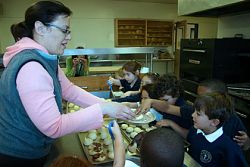Kindergarten students learn the meaning of Easter

SALT LAKE CITY — "Jesus died on the cross so we could live in heaven," said Alexa Punzo, a kindergarten student at Our Lady of Lourdes School, Salt Lake City. "And there was a crown of thorns on his head." After learning about Lent and the passion of Christ, the students in Katie Moose’s kindergarten class at Our Lady of Lourdes School retold the story in their own words. "The people were mean to Jesus because they did not like him," said Diata Whitfield. "They said he was not the real son of God." "They thought he was a criminal like a robber, so they killed him," said Deng James. "He resurrected from the dead and rose up from the grave," said Braxton Huntsman. "He came back alive from the dead." Moose is confident the students understand the concept of Easter and that Jesus died for our sins so we could live with him in heaven. She said the students were concerned about why the people were mean to Jesus. They did not like that at all. They also wanted to know about the crown of thorns and the nails because they realize how painful it must have been for Jesus to die that way. "The cross is a symbol God’s love," said Moose, as she made a transition into learning the old Easter custom of hot cross buns. Baking hot cross buns on Good Friday is an old English custom that has now extended into the whole season of Lent. At one time, it was believed the buns had special powers, and people hung them from their kitchen ceilings to protect their homes from evil. It was also believed that hot cross buns baked on Good Friday would never get moldy. "One legend connected with hot cross buns is about a monk who was a baker by trade," said Stephanie Metos, a parent assistant. "The monk became upset when he saw a lot of poor families, so he decided to make buns that could be given to the poor so they would not be hungry. He made them sweet because he felt the poor people needed something to cheer them up. "After they were baked, he put a cross made out of frosting on the top," said Metos. "Giving poor people something is showing them God’s love." The traditional hot cross buns have raisins or dried fruit to give them some taste, but no sweet filling because Lent is a penitential season. However, white icing is placed on the top and always in the shape of a cross as a reminder that Easter is coming.
© Copyright 2024 The Diocese of Salt Lake City. All rights reserved.

Stay Connected With Us